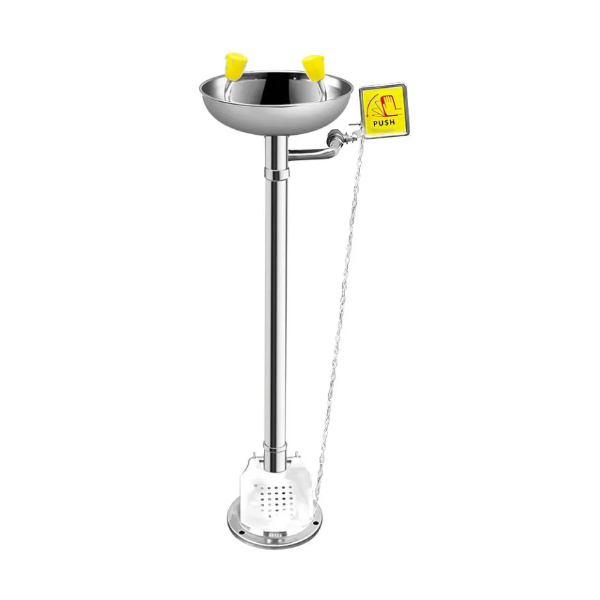Table of Contents
Do Eyewash Stations Need Tempered Water?
Eyewash stations are a critical part of workplace safety, providing immediate first aid to employees exposed to harmful substances. But one question that often arises is whether these stations need tempered water. Tempered water, which is neither too hot nor too cold, can make a significant difference in the effectiveness and comfort of an eyewash station, especially during emergencies. This article explores the importance of tempered water, recommended temperature guidelines, and the reasons behind this requirement.
What is Tempered Water?
Tempered water is water that’s maintained at a moderate temperature, typically between 60°F and 100°F (16°C to 38°C). This range is comfortable and safe for the sensitive eye tissue, which can be easily damaged by extreme temperatures. The American National Standards Institute (ANSI) recommends tempered water for all plumbed eyewash stations to ensure that users can rinse their eyes effectively without additional risks.
Why Tempered Water is Recommended for Eyewash Stations
The purpose of an eyewash station is to provide immediate relief by flushing contaminants from the eyes. If the water is too cold or too hot, it may discourage employees from rinsing their eyes for the recommended 15-minute duration. Here’s why tempered water is essential:
- Prevents Thermal Shock: Cold water, especially in winter, can cause shock to the body and make the experience uncomfortable, while hot water can further irritate or injure sensitive eye tissues.
- Encourages Proper Use: Employees are more likely to rinse their eyes for the full 15 minutes if the water temperature is comfortable. This extended flushing period is critical for removing contaminants and minimizing injury.
- Avoids Additional Damage: Using water that’s too hot can cause burns, while extremely cold water can lead to frostbite-like symptoms on the sensitive tissues of the eye.
ANSI Standards and OSHA Guidelines on Tempered Water
According to ANSI Z358.1, eyewash stations should deliver water at a temperature between 60°F and 100°F. While the Occupational Safety and Health Administration (OSHA) does not specify an exact water temperature, they reference ANSI standards as the benchmark for eyewash station compliance. Following ANSI’s guidelines helps organizations meet OSHA requirements and ensures that eyewash stations are safe and effective.
Why the Temperature Range?
The 60°F to 100°F range is selected to optimize comfort and safety:
- Below 60°F: Water this cold can be startling, and users may avoid flushing long enough to properly remove contaminants.
- Above 100°F: Water at this temperature may cause scalding or irritation, particularly in emergency situations where users may already have sensitive or injured tissues.
How to Ensure Tempered Water at Eyewash Stations
Ensuring that eyewash stations deliver tempered water requires some planning and maintenance. Here are several ways to provide tempered water in compliance with ANSI standards:
Thermostatic Mixing Valves
Thermostatic mixing valves are a popular solution to regulate water temperature at eyewash stations. These valves mix hot and cold water to maintain a consistent, comfortable temperature. They also prevent temperature fluctuations, which can occur due to changes in water pressure.
Dedicated Water Heaters
In facilities with cold climates, installing a dedicated water heater for the eyewash station can help maintain a safe water temperature. This solution is especially useful in outdoor or unheated environments where water may otherwise be too cold.
Regular Temperature Checks
Routine testing of the eyewash station ensures the water temperature remains within the safe range. Weekly inspections can confirm that the tempered water system is functioning properly, and maintenance can address any issues before they affect safety.
What Happens If Tempered Water Isn’t Available?
If tempered water isn’t available, the effectiveness of the eyewash station can be compromised. Here are a few potential risks:
- Reduced Flushing Time: Employees may avoid completing the required 15-minute flush if the water is too cold or too hot, increasing the risk of lasting eye damage.
- Increased Discomfort or Injury: Extreme water temperatures can cause additional injury or discomfort, leading to further complications in treating the original eye exposure.
- Non-Compliance Risks: Not meeting ANSI standards for eyewash stations could result in OSHA citations or fines, as OSHA relies on ANSI guidelines as the basis for eyewash safety requirements.
Tempered Water in Different Environments
Indoor Facilities
In controlled indoor environments, it is usually easier to regulate water temperature. By using thermostatic mixing valves and periodically testing water temperature, most indoor facilities can ensure their eyewash stations provide tempered water.
Outdoor Worksites
Outdoor and seasonal worksites present unique challenges for eyewash stations, especially in areas with extreme temperatures. Portable eyewash stations or units with built-in heaters may be necessary to provide tempered water at these locations.
Laboratories and Chemical Facilities
Laboratories handling hazardous chemicals should prioritize tempered water to protect employees working with substances that can cause serious eye injuries. In these settings, a comfortable temperature can make a critical difference in emergency response.
Conclusion
Tempered water is more than a recommendation for eyewash stations—it’s an essential feature that ensures comfort, safety, and compliance. By providing tempered water within the ANSI-specified range, workplaces can ensure that employees are more likely to use eyewash stations effectively and for the recommended time. With the right equipment, maintenance practices, and adherence to ANSI standards, you can create a safer workplace and help prevent serious eye injuries.
If your workplace does not currently have tempered water available at eyewash stations, consider upgrading your equipment to meet these essential safety standards. Your employees’ health and safety depend on it.




